Publication details
Department of Agriculture, Fisheries and Forestry, 2024
Download
New vehicle pre-loading biosecurity risk guide (PDF 3.3 MB)
If you have difficulty accessing these files, visit web accessibility for assistance.
Online version
New vehicles pose a biosecurity risk to Australia; exotic and highly invasive seed species that hitch a ride on new vehicles exported to Australia pose a high biosecurity risk. If biosecurity risks are not minimised by vehicle manufacturers offshore, there may be business impacts including:
- New vehicles held at the wharf for inspection by the Department of Agriculture, Fisheries and Forestry biosecurity officers.
- Increased surveillance for all vehicles.
- Wharf congestion; vehicle vessels unable to unload.
- Wharf charges.
- Charges for 100 per cent inspection for the same make and model (for example, when seed contamination is found).
- Charges for decontamination and re-inspection.
- Delays in meeting vehicle delivery orders.
Australia enjoys freedom from many of the world’s most damaging pests and diseases. There are many exotic pests and insects that could hitch a ride to Australia on new vehicles. If these pests establish in Australia they could have a detrimental impact on our agricultural and forestry industries, natural environment, food security and economy. Protecting Australia’s biosecurity is a shared responsibility between governments, industry and the community.
As an exporter you are responsible for making sure that all goods for export to Australia meet Australia’s import and biosecurity requirements, including being free of exotic insects and pests. Everyone in the supply and retail chain has a role in recognising and reporting any signs of pest activity in new vehicles. To avoid delays and additional costs to your business make sure you know what the import and biosecurity requirements are before you export your products.
- Be aware of the seed seasons in the country of export.
- Cover the new vehicles during transport from manufacturer to port.
- Work with wharf authorities to ensure port hygiene and remove vegetation that surrounds all wharf areas.
- Implement weed control measures such as mowing and slashing around all new vehicle standing areas.
- Before loading new vehicles onto the vessel, conduct a general walk-around inspection of all new vehicles. Look at all parts of the vehicles from different angles to ensure they are free of biosecurity risk material.
- Remove and replace contaminated or partly detached sticky wheel covers and other protective material, prior to loading.
- Consider setting up a biosecurity team that is responsible for all of the above activities.
Plant material is a high biosecurity risk and consists of living or dead plants or parts of plants. Plant material that you are likely to find includes:
- seeds – dormant or sprouted
- leaves, twigs, branches, sticks, straw, grass
- flowers and flower parts.
Vehicle surfaces are perfect locations for plant material to lodge. Plant material can carry exotic fungal pathogens or, in the case of seeds, be capable of germinating and introducing a pest plant species or a seed borne disease.
Examples of plant material found on new vehicles include:
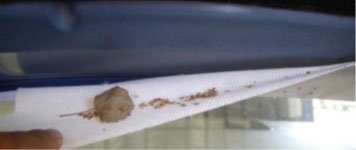 Leaves on the sticky surface of a plastic bonnet cover
Leaves on the sticky surface of a plastic bonnet cover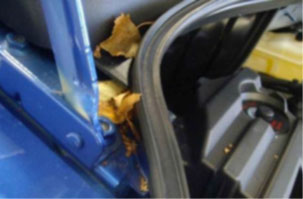 Leaves that have lodged around the plenum chamber area
Leaves that have lodged around the plenum chamber area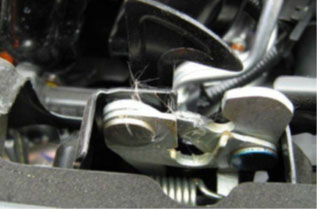 Seeds that have lodged in the bonnet latch
Seeds that have lodged in the bonnet latch Grain that has lodged around the plenum chamber area
Grain that has lodged around the plenum chamber area Seeds that have attached to the sticky surface of plastic wheel cover
Seeds that have attached to the sticky surface of plastic wheel cover
Soil materials pose a high biosecurity risk for Australia and include sand, gravel, stones, and rocks. These soil materials do not pose a biosecurity risk if they are clean and do not contain any organic matter or other biosecurity risk material.
Soil can be present as road splash; if the splash is 2 mm deep or less it is not a biosecurity risk. Soil as a contaminant on new vehicles will be present in larger quantities and can be found on surfaces such as floors, wheel arches and ledges.
Soil can carry fungal, viral and bacterial pathogens that are exotic to Australia.
Examples of soil found on new vehicles include:
 Soil splash (this level of soil is acceptable)
Soil splash (this level of soil is acceptable) Larger quantities of soil on a vehicle’s mudguard
Larger quantities of soil on a vehicle’s mudguard(this level of soil is not acceptable)
Animal material poses a high biosecurity risk to Australia and means material from animal origin including:
- nests – birds, rodents
- faeces – birds, rodents
- live animals.
Vehicle surfaces are perfect locations for animal material to lodge. Animal material can carry viral or bacterial pathogens.
Examples of animal material found on new vehicles include:
 Bird nests found in the engine bay of a vehicle
Bird nests found in the engine bay of a vehicle Feather found on the roof of a vehicle
Feather found on the roof of a vehicle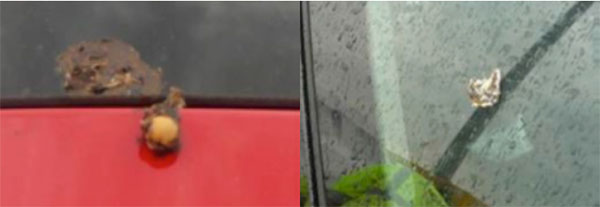 Bird faeces found on a vehicle whilst in storage or transit
Bird faeces found on a vehicle whilst in storage or transit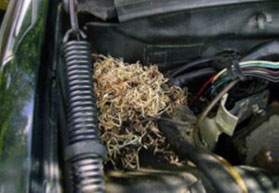 Rodent nest found in the engine bay
Rodent nest found in the engine bay Live gecko alighting from a vehicle
Live gecko alighting from a vehicle
Insects and snails find their way onto new vehicles for a number of reasons including:
- shade
- shelter
- food source
- surface to make a nest
- movement from one place to another.
Examples of insects and snails on new vehicles:
 Moths and their egg mass
Moths and their egg mass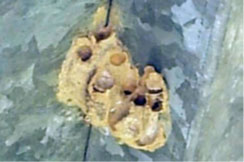 Mud nests made by wasps
Mud nests made by wasps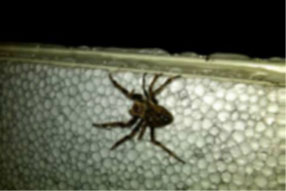 A spider with its eggs
A spider with its eggs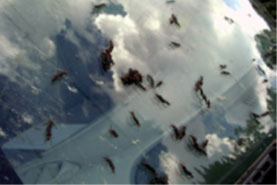 Bugs on a vehicle windscreen
Bugs on a vehicle windscreen Beetles in flight season
Beetles in flight season Snails hitching a ride
Snails hitching a ride
The two levels of contamination are:
- spot contamination
- widespread contamination.
Spot contamination
Spot contamination means small amounts of contamination that can be easily and immediately removed.
Examples of spot contamination on new vehicles:
 Feather
Feather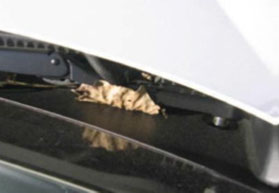 Small amount of leaves
Small amount of leaves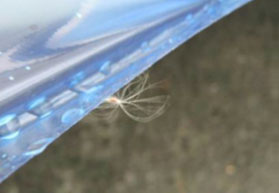 Small amount of seed
Small amount of seed Small amounts of animal contamination
Small amounts of animal contamination
Widespread contamination
Widespread contamination means a larger amount of contamination that cannot be easily and immediately removed, or contamination that is found in multiple areas on the vehicle.
Examples of widespread contamination on new vehicles:
 Large amount of grain
Large amount of grain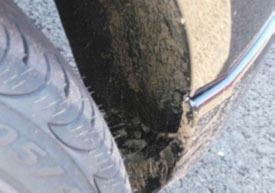 Large amount of soil
Large amount of soil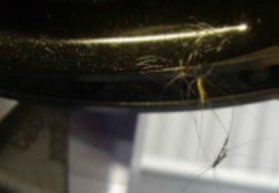 Large amount of seeds
Large amount of seeds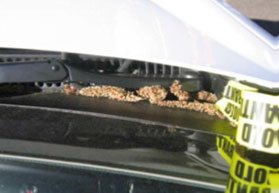 Large amount of plant material
Large amount of plant material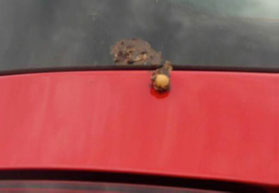 This quantity of animal contamination may take an effort to remove
This quantity of animal contamination may take an effort to remove Large amount of animal contamination
Large amount of animal contamination
Some areas of the vehicles are more likely to contain contamination than other areas. The likely contamination points are:
- plastic protective covers
- radiator, grille and air vents
- wheel arches
- window ledges
- under the car
- engine cavity.
As you inspect the vehicle, concentrate on these likely contamination points. (Note: images are indicative only.)
Protective coatings (plastic sheeting and painted-on)
All protective coatings should be checked to see if airborne seeds or plant material have stuck to them. After wet weather these seeds can be hard to find as they are small and tend to disappear under water droplets.
The plastic sheets would usually have contamination stuck to the corners where the sheets have not adhered to the paintwork, where the sheets have come away from the paintwork, or where sheets overhang the side of the panel. The painted-on protective coatings can have airborne seeds stuck to part of the coating.

Radiator, grille and air vents
The fins on the radiator, the corners of the grill and the air vents at the base of the windscreen are also ideal locations for captured airborne seeds and plant material.

Wheel arches
Wheel arches should be checked for soil that has clumped under the wheel arches or has splattered onto the paintwork. This site is favoured by moths to lay their eggs.
Wheel arches should be inspected for airborne seeds that could be caught on the sound proofing under the wheel arch or around any exposed grease on axles. Check the tops of mudguards and around the inside of the wheel arches—especially carpeted wheel arches—in case they have been contaminated.

Window ledges
The window ledges should be checked for any seed or other forms of contamination that has been caught in the rubber.
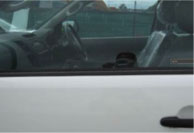
Under the car
Where possible, check the under surfaces of the vehicle while you are looking at the wheel arches.

Engine cavity
The engine cavity, including the soundproofing under the bonnet, must be checked for any contamination.

Other contamination points
Other areas that may require inspection include:
- boot
- door seals and locks
- the interior of the vehicle itself.
These areas are less likely to be contaminated. However, if evidence suggests these areas may be contaminated, then they must be inspected.
Boot
Inspect the boot latch for anything that may be caught in it. Inspect the spare wheel and spare wheel well for contaminants that may have blown in and lodged there.

Inspect the boot lining, any exposed wiring, and any storage compartments.

Door seals and locks
Inspect rubber door seals, locks and the greasy internals for contaminants.

Interior
Inspect the floors, especially behind the front seats and around the pedals for soil.

Inspect the vents, at the sides of the vehicle and across the dashboard.

Inspect the console, ashtrays, glove box and any front and rear storage compartments.


Inspect the seats, front and rear, dashboard and instrument panel.

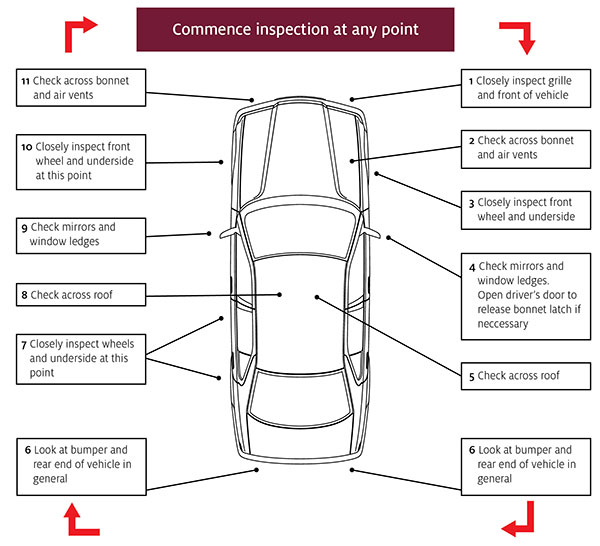
Treatment options
If contamination is found, it must be removed before the new vehicle is loaded onto the vessel.
Some vehicle cleaners have adopted the following treatments with success:
- Seed - hand picking the seed off with sticky tape or equivalent.
- Soil – pressure hose.
- Insects/snails – physical removal.
- Insect infestation – fumigation treatment.
When the vehicles arrive in Australia, the Department of Agriculture, Fisheries and Forestry biosecurity officers will conduct surveillance inspections to ensure compliance with Australia’s import requirements.
Watch our video to learn more about the vehicle inspection process.
New vehicle inspection process
Download
If you have difficulty accessing these files, visit web accessibility for assistance.
If the shipment does not meet Australia’s requirements, the Department may:
- conduct further inspections
- take remedial action to address the biosecurity risk.
